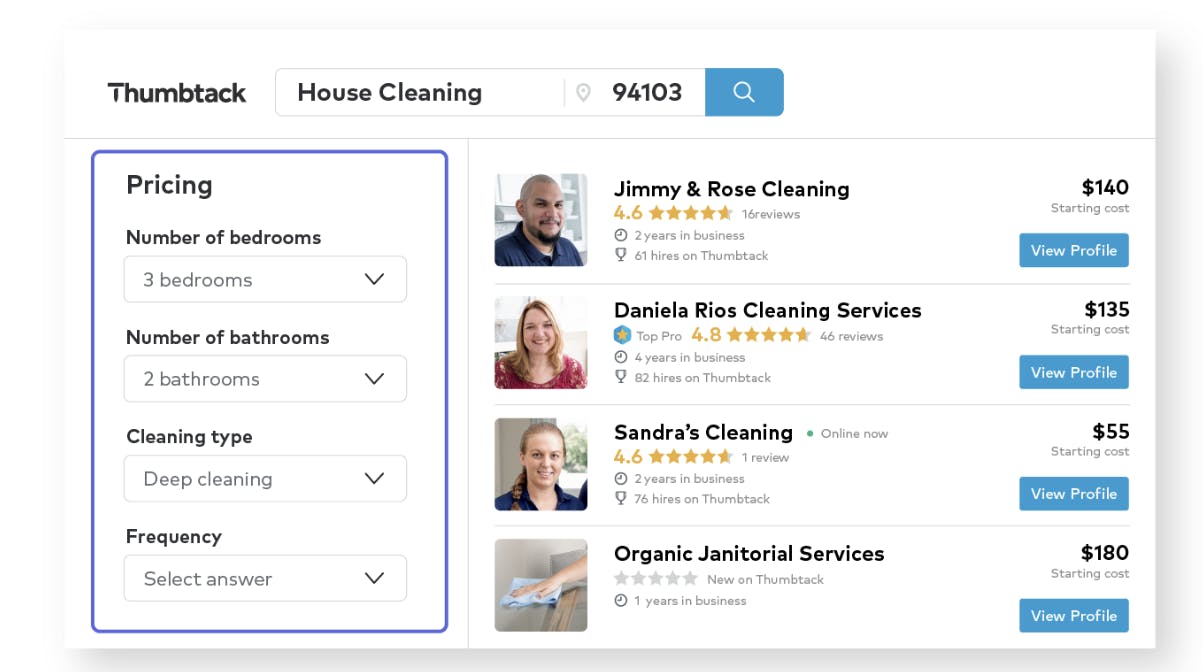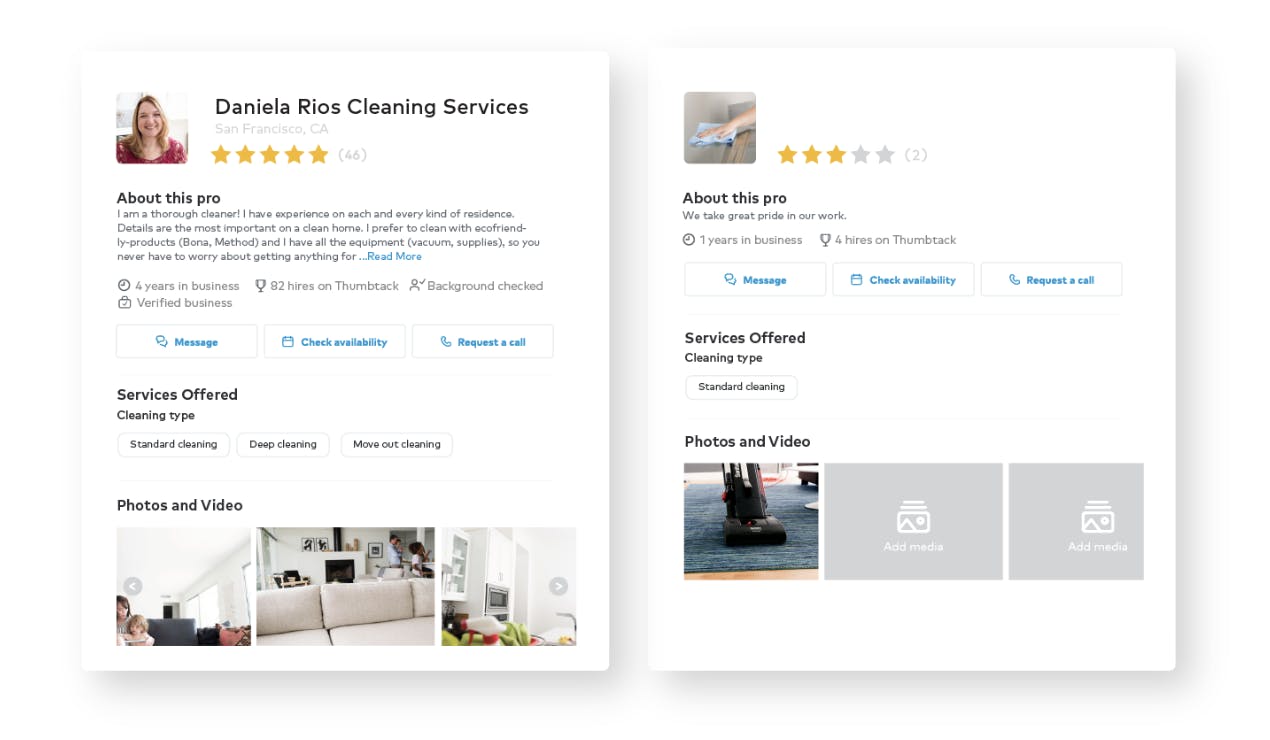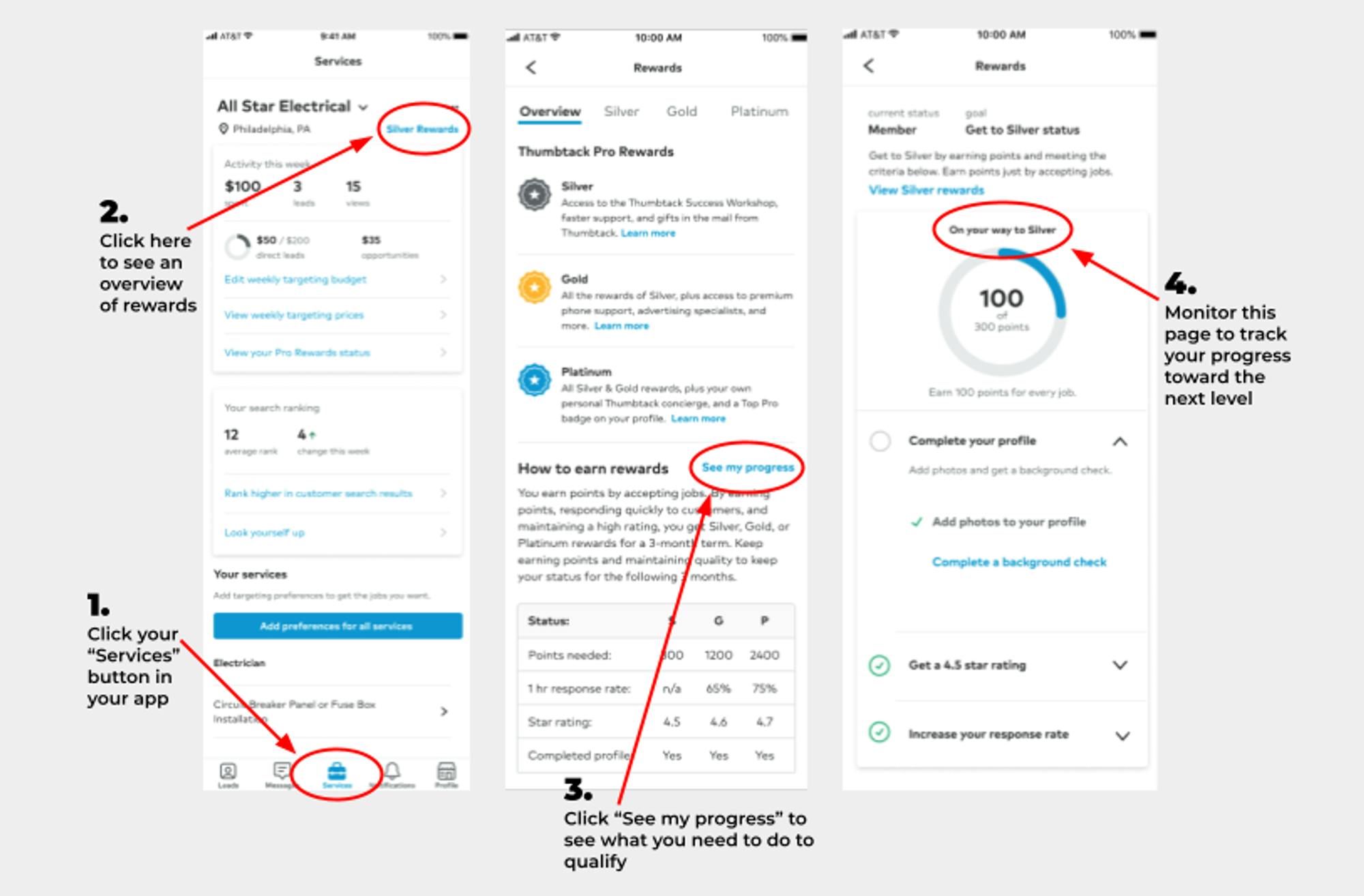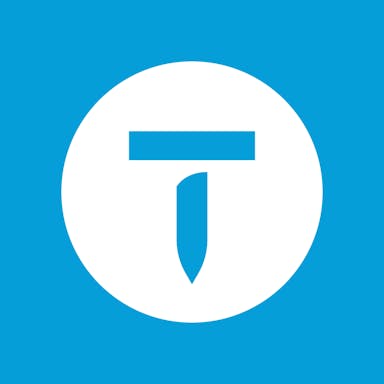Thesis
Homeownership is more complex than it may initially seem. Annual home improvement projects including maintenance, repairs, and renovations are expected to cost $30K on average as of 2024. According to a survey Thumbtack conducted of 2K homeowners in 2024, 83% of first-time homeowners found home projects much more time-consuming than anticipated. Additionally, with more than two-thirds of Americans spending more time at home in 2022 compared to 2020, there is a growing focus on improving the quality of their homes.
Many home improvement specialists operate within the “gig economy”, a labor market primarily consisting of freelancers and independent contractors seeking part-time and temporary positions. This sector is rapidly expanding, projected to grow to 50% of the US economy from 2023 to 2027. The increasing demand for home improvement, coupled with a growing pool of gig workers, has led homeowners to leverage technology for managing home projects and connecting with freelance workers. In fact, over 55% of homeowners conduct online searches for various home services such as moving, pest control, and lawn care before engaging professionals as of May 2024.
Thumbtack is an online platform that connects local service providers with users. Thumbtack's providers were initially focused on home improvement but have expanded their services beyond that to a wide range of needs including painting, photography, pet grooming, business consulting, and event planning. Thumbtack's platform was developed as an alternative to traditional methods of finding local professionals, such as directory listings or word-of-mouth referrals.
Founding Story
Thumbtack was founded in 2008 by Marco Zappacosta (CEO), Jonathan Swanson (chairman), and Sander Daniels.
None of the company’s co-founders initially pursued entrepreneurship as a career path. Swanson, who graduated from Yale University in 2006, was originally interested in politics and economics. After interning at the White House during his undergraduate years, Swanson co-founded a nonprofit organization called Students for Saving Social Security with Zappacosta. The organization grew to over 10K students across 300 college campuses.
Upon graduating, both Swanson and Zappacosta realized that the political world was not for them. Swanson resigned from his position as an economic policy analyst in the George W. Bush administration to co-found Thumbtack with Zappacosta in 2008.
Daniels, also a Yale graduate, initially pursued a career in law and politics. He completed his undergraduate degree in 2005 and graduated from Yale Law School in 2009. During his time as an undergrad, Daniels was friends with Swanson and later participated in weekly brainstorming sessions with Swanson and Zappacosta about their startup ideas when he was in law school.
After moving to San Francisco to develop Thumbtack, the team faced many rejections from investors. Swanson recalls pitching to 42 separate investors and being rejected by all of them. However, the team persevered and eventually secured funding through the angel investor network of one of Zappacosta’s mentors, which included notable investors such as Jason Calacanis, Joshua Schachter, Scott Banister, and Naval Ravikant.
Later additions to Thumbtack’s executive team include Llibert Argerich, who joined as the company’s first chief marketing officer in July 2023, and Mark Poston, who became the first chief commercial officer at the end of 2023. Additionally, Jelena Djordjevic was promoted to chief people officer in April 2024 after serving as VP of the People team for three years.
Product
Thumbtack is an online marketplace connecting customers with local service professionals across 1.1K services, ranging from home improvement to event services. The platform consists of two main components: a customer-facing platform and a professional-facing platform.
Thumbtack connects customers, such as homeowners, with vetted local service providers while helping professionals grow their businesses through targeted leads. Key use cases include homeowners finding contractors for repairs or renovations, individuals booking services like personal training or music lessons, and event planners hiring caterers, photographers, or DJs.
Initially, Thumbtack operated similarly to Craigslist with a manual process for connecting customers and professionals. Customers would answer questions to formalize a job request, which Thumbtack would send to relevant professionals (pros). Pros would scan through hundreds of requests, looking for suitable matches. When pros found a job, they would send a quote and were only charged when a customer viewed it. This process proved inefficient. Pros often lacked the time to constantly monitor their phones and sift through requests to find the best matches.
To address this, Thumbtack developed an Instant Matching feature in late 2016, officially launching it in 2017. The feature considered pros’ preferences for jobs, geographical areas, availability, and budget, allowing Thumbtack to instantly match pros with suitable customers.
For Customers

Source: Thumbtack
Thumbtack's customer-facing products have several features that center around its core offering, Service Marketplace, which connects users with local professionals across various categories. Features include:
Instant Book, which allows immediate service bookings at fixed prices.
Thumbtack Guarantee, which offers customers protection of up to $1K for property damage.
Thumbtack Plus, a membership program that provides enhanced benefits to customers like priority support, enhanced protection, and discounted services.
Mobile App, which allows customers to access Thumbtack’s services through Thumbtack's mobile app, available on iOS and Android.
Cost Estimates, which provide customers with pricing insights for various services. The tool is designed to give users a ballpark figure of what they might expect to pay for different projects or services. For example, the national average for handyman work was priced between $60 to $70 per hour as of July 2024.
A Home Resource Center that provides customers with project guides, how-to articles, cost guides, and news and data related to various home projects.
Home Inspiration Pictures, a visual resource that provides customers with a gallery of real home projects completed by Thumbtack professionals, offering inspiration and ideas for various areas of the home including living rooms, kitchens, dining rooms, and bedrooms, helping customers envision potential improvements for their own spaces.
In April 2024, Thumbtack introduced numerous new product features for customers including an AI-powered search function to assist users in articulating their service needs more effectively and Actionable Plans, for tracking project progress, setting reminders, and gaining insights into the value of various projects.
For Pros

Source: Thumbtack
For service providers, Thumbtack offers Thumbtack Pro, a suite of business management tools. This includes lead management features to help professionals track and respond to potential clients. Features include:
Thumbtack Profile, a place where professionals can showcase their services, expertise, and photos of past work.
A Community platform for professionals to connect, share experiences, and get support.
Pro Resources for professionals to learn how to set up and optimize their Thumbtack profiles.
Pro Reviews, where professionals can view and manage their customer reviews.
Mobile App for Pros, which allows professionals to manage their Thumbtack business on mobile, including sending quotes and responding to customer inquiries.
Scheduling Tools, which provide a way to organize appointments and manage bookings.
Messaging features that facilitate interactions between professionals and clients.

Source: Thumbtack
Thumbtack also offers a Pro Rewards program to help professionals distinguish themselves on the platform. The program consists of three tiers: Silver, Gold, and Platinum. Pros can qualify for each tier by earning points from responding to new leads and accepting jobs. The program has four qualifying periods per year: December to February, March to May, June to August, and September to November. The rewards offered through this program include access to workshops, marketing courses, priority support, and a Top Pro badge for the highest tier.
Market
Customer
Thumbtack caters to two primary customer segments: freelancers service providers and service seekers.
Freelance service providers encompass over 300K local business owners across diverse categories such as home services, events, lessons, and wellness as of August 2024. Among home services categories in 2023, some of the fastest-growing categories year-over-year included sink or faucet repair (205.3%), room remodels (143.2%), and home construction services (90.8%).
Notably, house cleaning, handyman, property management, junk removal, and furniture assembly were the top five services that saw the highest influx of new business signups in 2023. The freelancer side of the market appears to be more readily accessible, evidenced by the 40% growth in new businesses joining the platform from 2021 to 2023.
Services seekers include users, consumers, and homeowners looking to hire local professionals for various projects and tasks. Thumbtack had over 10 million registered users on the platform as of 2022.
Market Size
Thumbtack operates in the global hyperlocal services market, which encompasses the on-demand delivery of goods and services. This market includes various sectors such as home services (cleaning, repairs, renovations), personal services (fitness, tutoring, pet care), professional services (accounting, legal), and local retail and food delivery. As of 2021, the hyperlocal services market was valued at $1.5 trillion and was estimated to reach $5.9 trillion by 2031, growing at a 14.4% CAGR.
Within this broader market, the home improvement segment, which comprises a significant part of Thumbtack's business, was valued at $867.6 billion as of 2023. This segment is expected to grow at a 6% CAGR between 2024 and 2032, potentially reaching an estimated market size of $1.3 trillion by 2032.
The potential TAM for Thumbtack could encompass both US adults seeking services and freelancers or gig workers offering services. As of 2023, the US adult population is 262 million. The gig economy is estimated to total 76.4 million people in the US as of 2024, a number which has been growing by two million per year since 2017.
Competition
Direct Competitors
TaskRabbit: Founded in 2008, TaskRabbit is an online marketplace that connects professionals with users for same-day services such as furniture assembly, handy work, and moving assistance. In 2017, IKEA acquired TaskRabbit for an undisclosed amount. TaskRabbit continues to operate independently, while IKEA holds 100% of the shares in the company. Prior to the acquisition, TaskRabbit raised a total of $37.7 million from notable investors such as Founders Fund and Shasta Ventures.
While both TaskRabbit and Thumbtack connect users with professionals, TaskRabbit focuses on people earning a side income from providing one-off tasks such as mounting a TV or assembling furniture. TaskRabbit's revenue model differs from Thumbtack's, as it charges customers a service fee on top of the professional’s hourly rate. However, TaskRabbit is free for professionals aside from a $25 registration fee, while Thumbtack generates revenue from professionals paying for leads.
TaskRabbit and Thumbtack also differ in their approach to job allocation. While Thumbtack implements a bidding system where professionals can submit quotes to compete for customers, TaskRabbit uses a more straightforward booking process without this competitive feature. Despite this difference, both platforms aim to streamline the connection between service providers and customers by simplifying the hiring process.
Angi: Founded in 1995, Angi connects home service professionals with homeowners for various projects, including architectural and appliance services. The company raised a total of $180.3 million from notable investors like Battery Ventures, Headline, and Bridge Bank before going public in 2011. In 2017, Angi was acquired by IAC and merged with HomeAdvisor to form ANGI Homeservices. As of August 2024, Angi's market cap was $1.3 billion.
Thumbtack and Angi are marketplaces that connect freelancers with users but differ in key respects. Thumbtack offers a wide range of services, while Angi focuses on home services. Angi uses a tiered membership system for users, while Thumbtack provides free access to its platform. Their review systems also differ. On Thumbtack, users can write personalized reviews after hiring a professional. Angi uses a grading system where customers rate professionals on a scale of A to F across multiple categories, resulting in an automated average score. Both platforms operate similarly, with Thumbtack offering more variety and Angi specializing in-home services.
Porch Group: Founded in 2013, Porch Group connects homeowners with businesses providing services like a moving concierge, home repair, and security. The Porch Group owns a number of gig economy marketplaces like Porch, Hire a Helper, and IRoofing. The company raised a total of $648.8 million in funding from investors such as Runway Growth Capital, Wellington Management, and Valor Equity Partners prior to going public in December 2020 via a reverse merger with PropTech Acquisition Corp. As of August 2024, Porch Group’s market cap was $154.4 million.
Unlike Thumbtack, where users choose from a selection of qualified freelancers, Porch allows users to specify their project details, and contractors can browse and select from job postings. Porch also uses a subscription-based model for professionals based on their service and area, contrasting with Thumbtack's per-lead fee structure. Therefore, Porch is similar to Thumbtack in providing an online marketplace but differs in the business model and type of services it offers.
Adjacent Competitors
Yelp: Founded in 2004, Yelp is an online platform that connects people with local businesses through crowd-sourced reviews and ratings. Yelp allows users to write reviews, browse photos, and find detailed information on businesses ranging from restaurants to home services. Before going public in 2012, Yelp raised $56 million in funding across six rounds, with the last Series E round led by Elevation Partners. As of August 2024, Yelp’s market cap was $2.2 billion.
While both Yelp and Thumbtack connect users with businesses, Yelp primarily functions as a review platform, whereas Thumbtack operates as an online marketplace. Yelp allows anyone to leave a review, while Thumbtack requires job completion for reviews. Thumbtack has over 2K services that it offers to users in contrast to Yelp’s listing of over 25 types of businesses. Yelp has a broader geographical reach, covering over 35 countries, compared to Thumbtack's focus on the 50 US states. Therefore, while Yelp and Thumbtack have some similarities, the business model, operations, and product offerings are distinct.
Traditional Methods
Word of Mouth: Word-of-mouth referrals remain an important source of business for professionals in the home services industry. As of 2020, 88% of contractors reported using word of mouth to grow their business. This method allows contractors to leverage their existing networks for free, potentially limiting their need for digital marketplaces like Thumbtack.
Business Model
Thumbtack generates revenue in four ways:
Lead fees: Thumbtack’s primary revenue stream comes from charging service professionals for leads they receive through the platform. When customers submit service requests, Thumbtack matches them with relevant professionals, who then pay a fee to Thumbtack to contact the customer and potentially secure the job. The fee model allows Thumbtack to earn revenue from each potential transaction without charging customers directly.
Subscription fees: Thumbtack offers Thumbtack Plus, a subscription service priced at $49 annually as of 2023. The program provides homeowners with benefits like project planning support and other perks like customer support and access to exclusive leads. The subscription model ensures a steady income stream for Thumbtack and helps service providers manage expenses more effectively.
Advertising: Thumbtack provides advertising opportunities for professionals to promote their services on Thumbtack, enhancing their visibility and increasing their chances of being hired.
Listing fee: In some instances, Thumbtack charges service providers a fee for publishing new listings. This approach can encourage providers to create more listings, potentially increasing their visibility and customer reach. However, if listing fees are too expensive, it may be difficult for providers to see a worthwhile return on their investment.
Lead fees, Thumbtack's primary source of revenue, are charged at different tiers. The cost for professionals to contact leads varies based on the estimated value of the job, allowing Thumbtack to optimize its revenue based on project size. Professionals buy credits to send quotes to potential clients. Credit prices range from $1.42 to $1.50 with bulk options like 24 credits for $34.99 and 60 credits for around $84.99. Notably, Thumbtack does not charge for completed jobs or jobs from repeat customers and their referrals.
Traction
In 2021, Thumbtack’s gross revenue was reported to have grown by over 50% year-over-year, with expectations to facilitate more than $2 billion in transactions for service providers that year. By August 2024, Thumbtack had initiated over 80 million projects, reporting billions of dollars earned by professionals through the platform. In 2022, Thumbtack had 10 million active customers. It reportedly grew by four million customers in the 12 months leading up to 2024.
As of August 2024, Thumbtack operates in all 50 states in the US, with professionals available in every county. The platform had more than 300K active service professionals across 1.1K service categories. As of August 2024, Thumbtack had a 4.9-star average rating on the Apple Store, and the company claimed to have accumulated a total of over 10 million five-star reviews.
In July 2024, Thumbtack announced a partnership with MyMove, a subsidiary of Red Ventures. This collaboration allows users of MyMove and other Red Ventures subsidiaries to search and book Thumbtack professionals for various home projects, further extending Thumbtack's reach through Red Ventures' network, which includes platforms like Allconnect and Bankrate.
Valuation
Thumbtack last raised a $75 million debt financing round in July 2024 led by Silicon Valley Bank and Hercules Capital. Prior to this, it raised a $275 million Series G round at a $3.2 billion valuation led by Qatar Investment Authority in June 2021. As of August 2024, the company raised a total of $773.2 million in funding with the support of notable investors such as Sequoia Capital, Tiger Global Management, and Capital G.
Key Opportunities
Expanding Strategic Partnerships
Thumbtack can leverage strategic partnerships to enhance liquidity in its marketplace and expand its service offerings. Thumbtack has already explored this with its partnership with MyMove in July 2024. In early 2024, Thumbtack also partnered with ServiceTitan, a field service management company that helps field service providers run their business. This partnership allows service providers to manage their bookings and calendars in one centralized place.
By pursuing similar partnerships and integrations in the future, Thumbtack can broaden its reach and indirectly acquire more users by streamlining the hiring process on other platforms. This strategy could enhance Thumbtack's value proposition in the competitive gig economy landscape.
Expanding Service Categories
Thumbtack has the potential to expand its market reach by diversifying its service offerings. While the company has already expanded its scope beyond home services, there are still untapped areas that could attract a wider and more varied user base. For instance, the growing fields of UI/UX design, software development, and consulting are currently well-represented on other freelance platforms like Fiverr and Upwork, which have specialized contractors. By incorporating these specialized services, Thumbtack could compete in these markets and appeal to a broader range of clients and contractors.
Key Risks
Word-of-Mouth Referrals
The industry continues to rely heavily on word-of-mouth referrals, which may be an obstacle to Thumbtack's growth. Contractors often prefer these direct referrals as they avoid platform fees and foster more personal client relationships. This preference for traditional networking methods could hinder Thumbtack's market penetration and growth potential.
Controversial Business Model
Thumbtack's revenue model, which charges professionals for customer leads regardless of job acquisition, has come under scrutiny. Thumbtack Community forums have reported rising lead prices, leading to growing skepticism about the platform's fairness. This dissatisfaction among service providers, who are crucial to Thumbtack's business model, presents a significant risk. If a substantial number of professionals leave the platform due to perceived unfairness, it could result in both financial losses and reputational damage, making it challenging for Thumbtack to attract and retain quality service providers.
Scaling Challenges
Thumbtack's success is closely tied to both the availability and satisfaction of service providers on its platform. The platform's success there hinges on liquidity — balancing customer demand with high-quality service providers. As customer interest grows, the need for high-quality service professionals to handle the increasing volume of requests also rises.
Properly vetting each service professional is time-consuming, and some professions, particularly within the skilled trades, are experiencing significant labor shortages. This makes it difficult to maintain the quality of service providers. While user reviews exist, they can be biased, making them unreliable for evaluating contractor performance. If Thumbtack fails to maintain service quality as it scales, it risks decreased customer satisfaction and retention, potentially undermining the platform's long-term viability.
Summary
Thumbtack operates an online marketplace connecting users with professionals across 1.1K service categories. Founded in 2008, the company has expanded its reach to all 50 US states, with 300K professionals on its platform and over 70 million completed projects. The company's growth is tied to that of the gig economy. However, Thumbtack faces challenges in maintaining service quality as it scales, retaining skilled professionals, and expanding its user base. The company's ability to address these issues will likely influence its future performance and market position.



